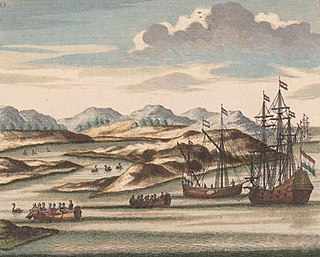
The human history of Western Australia commenced between 40,000 and 60,000 years ago with the arrival of Indigenous Australians on the northwest coast. The first inhabitants expanded across the east and south of the continent.

The Swan River Colony, also known as the Swan River Settlement, or just Swan River, was a British colony established in 1829 on the Swan River, in Western Australia. This initial settlement place on the Swan River was soon named Perth, and it became the capital city of Western Australia.

Thomas Peel was one of the very early settlers of Western Australia. He was a second cousin of Sir Robert Peel. He was part of the military force behind the Pinjarra massacre in 1834, which saw 15-80 of the indigenous Binjareb people killed.

Lieutenant-Colonel Frederick Chidley Irwin, KH was acting Governor of Western Australia from 1847 to 1848.
Robert Menli Lyon was a pioneering Western Australian settler who became one of the earliest outspoken advocates for Indigenous Australian rights and welfare in the colony. He published the first information on the Aboriginal language of the Perth area.

Lieutenant Robert Dale was the first European explorer to cross the Darling Range in Western Australia.
Midgegooroo was an Aboriginal Australian elder of the Nyungar nation, who played a key role in Aboriginal resistance to white settlement in the area of Perth, Western Australia. Everything documented about Midgegooroo is mediated through the eyes of the colonisers, some of whom, notably G.F. Moore, Robert Menli Lyon and Francis Armstrong, derived their information from discussions with contemporary Noongar people, in particular the son of Midgegooroo, Yagan. Largely due to his exploits in opposing colonisation and his relationship with Lyon and Moore, Yagan has a much sharper historical profile than his father. Midgegooroo was executed by firing squad and without trial under the authority of Lieutenant Governor Frederick Irwin in 1833.

The Pinjarra massacre, also known as the Battle of Pinjarra, is an attack that occurred in 1834 at Pinjarra, Western Australia on an uncertain number of Binjareb Noongar people by a detachment of 25 soldiers, police and settlers led by Governor James Stirling. Stirling estimated the Binjareb present numbered "about 60 or 70" and John Roe, who also participated, at about 70–80, which roughly agree with an estimate of 70 by an unidentified eyewitness.
Calyute, also known as Kalyute, Galyute or Wongir, was an Indigenous Australian resistance leader who was involved in a number of reprisal attacks with white settlers and members of other tribes in the early days of the Swan River Colony, in Western Australia. He was a member of the Pindjarup people from around the Murray River area south of Perth. Calyute's family included two brothers, Woodan and Yanmar, two wives, Mindup and Yamup, and two sons, Ninia and Monang.
Dr Alexander Collie was a Scottish surgeon and botanist who journeyed to Western Australia in 1829, where he was an explorer and Colonial Surgeon.

The Murray River is a river in the southwest of Western Australia. It played a significant part in the expansion of settlement in the area south of Perth after the arrival of British settlers at the Swan River Colony in 1829.

Western Australia Day is a public holiday in Western Australia, celebrated on the first Monday in June each year to commemorate the founding of the Swan River Colony in 1829. Because of the celebration of Western Australia Day, WA does not celebrate the Queen's Birthday Holiday in June, as do the other Australian states; it is held in September or October instead.
Henry Trigg (1791–1882) was the Superintendent of Public Works in Western Australia from 1839 to 1851 and founder of the Congregational Church in Perth.
Thomas Watson was a surveyor and early settler of the Swan River Colony in what is now Western Australia.
Richard Goldsmith Meares (1780-1862) was an early landholder and public official at the Swan River Colony in Western Australia.
Samuel Edward Moore was a prominent early settler in colonial Western Australia, a merchant, pastoralist and a politician.
William Lane Milligan (1795–1851) was a British military surgeon. He became an early resident of the Swan River Colony in Western Australia.
Erskine Link, once known as Bay Street, is situated in East Perth between Hay Street and Adelaide Terrace.
Arthur Trimmer (1805–1877) was one of three brothers who were early settlers in the colony of Western Australia. He was the grandson of Sarah Trimmer (1741–1810), an educational reformer and writer. Arthur’s father was William Kirby Trimmer who married Jane Bayne in 1794, with whom he had seven children. He owned a successful brickmaking business and collected fossils. He suffered a stroke in 1810 and died four months later, when Arthur was only five.
The Reverend Dr Louis Giustiniani was the first missionary to the Swan River Colony. He was zealous in defending the interests of aborigines but alienated the colony and was removed from office.








